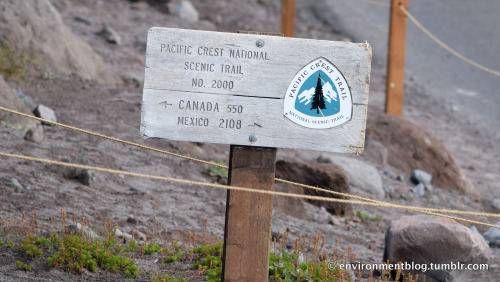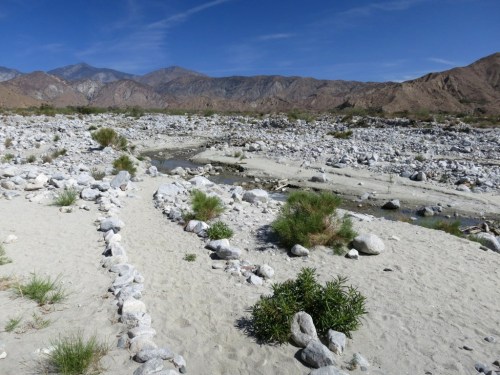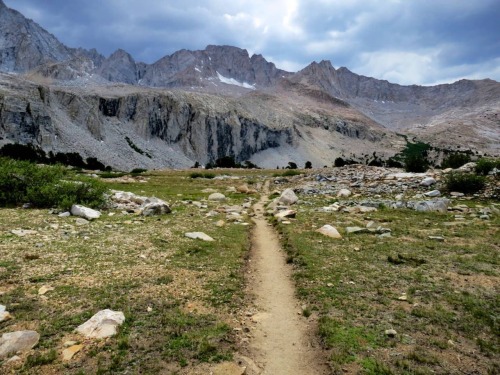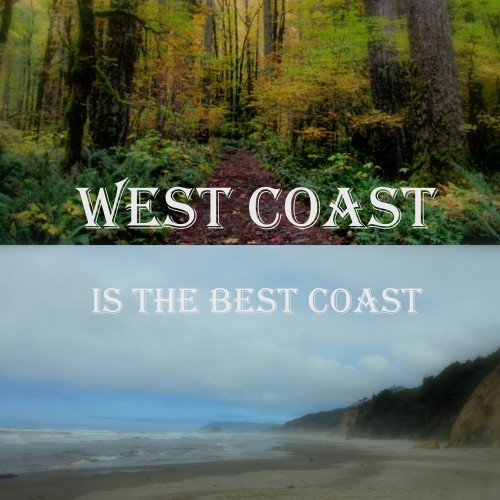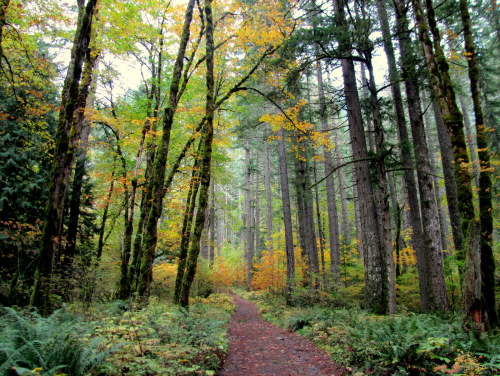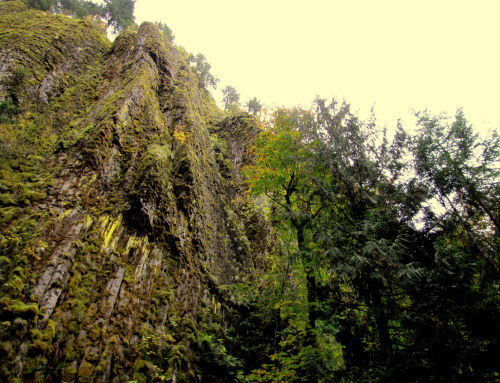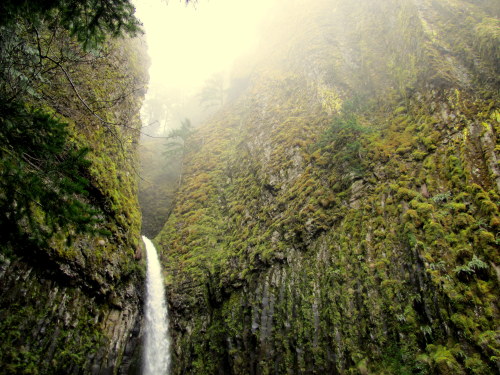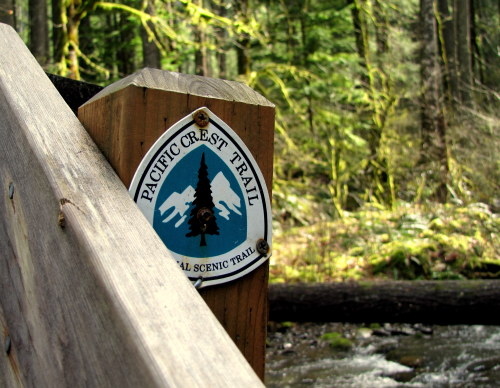#pacific crest trail
The Pacific Crest Trail
- stretches from Canada all the way south to Mexico following many mountain ranges in Washington, Oregon and California. If you’ve ever been, you know how beautiful it is.Post link

Pacific Crest Trail. Washington State.
Days away from the end of our yearlong journey I sit in a dark theater and watch a lone women staring down the barrel of a solo, thousand mile trek through the wilderness. At the very first sign post, loaded up with the weight of too much ambition and a monstrous pack, she pulls a journal from a small box by the road and writes a simple message I wish I had heard before the start of our odyssey: “If your nerve deny you, go above your nerve.” – Emily Dickinson. It’s a perfect way to start on her path as much as Wild is the perfect way to end mine.

In Wild, Reese Witherspoon gives us her defining performance as Cheryl Strayed, a divorcee and former drug addict who’s life has spun out of control after an abusive childhood and a family loss. The film follows her journey of self-discovery through adversity at the hands of the 1,100 miles of the Pacific Crest Trail: a wilderness trek stretching from Mexico to Canada. At first the Cheryl we meet is spunky and strong albeit clearly working through some relationship issues. She unpacks and repacks her insane amount of hiking gear in the cheap motel she rented from a suspicious inn keep. She hitchhikes to the trailhead, the music on the radio causing flashbacks to dancing as a child with her mother. She’s dropped off, loaded up, and then she is alone staring at the first segment of her epic journey: The Mojave Desert. No more than 100 feet into the trail a thin, echoed voice from inside Cheryl’s head asks, “What the fuck am I doing?”

It’s access to that internal monologue that sets Wild apart from other extreme isolation movies like Cast Away and All is Lost. And it’s those splintery flashes of memory that keep us firmly rooted in the journey while still giving us insight into her past. In fact it’s these devices, more so than the powerful story or even Witherspoon’s honest, understated performance that truly set the film apart from similar journey epics like 2010’s The Way. The flashback sequences, such as they are, are often momentary and overlaid with the audio from present scene. Even the more lengthy ones sprout organically from memory triggers and blend back into the present with audiovisual overhangs. Along with access to Cheryl’s internal voice, all the while singing bits of songs caught in her head or asking herself questions, it is the most realistic portrayal of how a person actually thinks and how memory actually works that I’ve ever seen on screen.
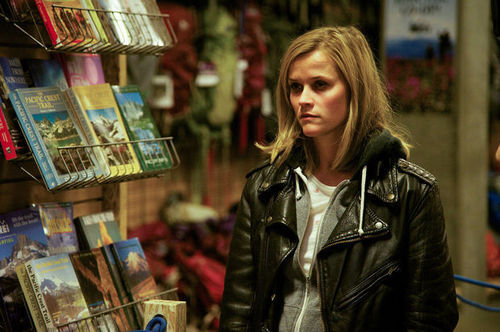
The deeper into the journey she goes the more we see of the life that led her here. The failed marriage, the infidelity, the drugs, the abortion, and great personal losses all bubble up and burst on screen only to disappear as quick as they came for us to watch Cheryl’s face as she relives them. To it’s credit though, even with all the deplorable acts and horrible memories we watch Cheryl live through, it never feels like the unbearable punitive tragedy porn we get from films like The Road or even this year’s Unbroken. Every memory has a reason and adds a layer of understanding and empathy, or shock and enmity to this character we thought we knew. What we end up with is a real, relatable picture of a broken woman trying to walk herself back to the woman her mother raised her to be.
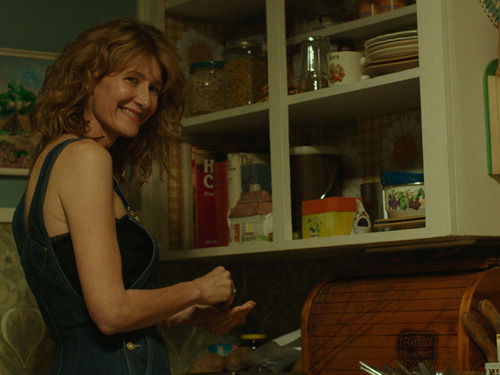
The story itself is not trivial either. The challenges she faces along the trail and the people she meets are all deeply interesting. Her backstory is fleshed out piece by piece in digestible, carefully distributed chunks. The film lends credence to the lack of safety a woman alone can face without bending the actual facts of the story. There are genuine moments of hardship, triumph, and joy. It never tries too hard or shouts too loud. It is simply the delicate, ugly, awesome truth of a life.

Over the last year we’ve loved, hated, griped, cheated, and risen to the occasion all in equal measure. What seems simple, as an idea (such as ‘lets review a movie every day’ or ‘I’m going to hike the Pacific Crest Trail’) becomes an unwieldy beast you have to battle every day. There are pitfalls and victories, roadblocks and easy days. As hard as it is if you take the time once in a while to stop and look around, to see how far you’ve come, dream about what you can do with the time you have left, and put yourself in the way of beauty, what went from simple thought to impossible task reveals itself for what it always was: a great adventure.
-Andrew
Time For Spring
In a few days it will be the ‘official’ start of spring. It signals the time to get outside…really get outside. Some of us don’t let a little thing like winter slow us down, we tromp, ski, splash our way through the season while still others hunker down and like some other mammals kind of go into a form of hibernation. Here we are in March waking up from our winter slumber. Many are leaving even their masks behind after two years of keeping them close. The combination of shedding a mask while embracing the coming spring is exciting to say the least.

Here are some notes about going outside. Going outside supports real-time experiences through a mind-body connection. One nice thing about going outside is it can be completely hands-free. No keyboards, touch screens, controllers, or joysticks. One gets to use their hands as they were meant to be used; eating, holding, squeezing, embracing, etc.
Going outside provides a very authentic 3-D, real time motion video, without any lag time. There are a whole range of available colors that our eyes really like. Spring time welcomes the bursts of colors that have been waiting for this moment.
The orientations of the things we view occur in both Landscape Mode and Portrait Mode. For Landscape Mode, all you have to do is look straight ahead. To see things to the left or right, just shift your eyes in their sockets or turn your head from one side to the other. For Portrait Mode, simply tilt your head ninety degrees in either direction and use your eyes as you normally would.
From an auditory standpoint being outside provides a true surround sound experience. No headphones, earbuds, speakers, or sound bars are necessary. Just by listening, you hear everything, the frogs and birds, the water, the wind, yourself breathing, plus added bonuses such as a distant coyote call, or the splash of waves on the beach.
Smells are one more gift we get from being outside. Scents are all around. There is not one technology that comes close. No matter how hard you squeeze your phone no notable smell will emerge to dance in your nostrils. Spring launches flowers in all of their glory so along with our eyes we pair what we see with what we smell. Amazing! Beyond flowers there are numerous other scents, some good to great and some, well not so good or great. Being outside requires us to take the positives with the negatives as that is the balance of nature.
Textures are real and getting outside puts us in touch (pun intended) with what grass feels like or how smooth or rough a rock is. Just from being outside and touching things you will be shocked by the wide variety of things to be found there. From the prickle of fir needles to the velvet smoothness of a flower’s petal.

Being outside also provides another way to interact with a whole range of people. It can go from one to tens, hundreds, and even thousands. Passing another person you may do nothing more than share a knowing look or smile. You may even offer a soft 'hello’ or some other acknowledgement found in the shared joy of being outside. Of course, there is always the exchanges you can have with yourself through self reflection and self talk. This can often be most enlightening. It is all out there!
Spring brings great shifts and swings in weather. By putting yourself outside you will feel if it is hot, cold, or in between. You will know when it is windy, rainy, or sunny. If you go out at night the crisp spring air and a bright moon may greet you along with stars or rolling clouds. You could be surprised by a soft mist of light rain or notice fog shrouding your familiar surroundings.
After the spring season draws you outside you may notice other people just like yourself awakening like the birds, trees, and flowers and so much more. Take a good listen, look, touch, and smell and see what happens. It may surprise you…
The View From Here
There is the old adage, “Put one foot in front of the other…” Those words hold true especially when we are hiking along the trail in our effort to get from one place to the next. Often those words serve as guides particularly when the weather is least cooperative. It is in those ‘other’ times that I am awed by one other feature of walking.
I love looking back from where I came from. It is truly awe inspiring to realize my feet, my legs, my entire being got me to where I am. In my typical day to day life the distance between the points I travel is shortened by getting in a car or hopping on my bike. Going to a friends, or work, or to some other destination is shortened and blurred by the fact I am using a vehicle. Granted, pedaling my bike takes physical energy and endurance that a motorized vehicle does not require this still seems different from walking.
When hiking it is all on me. Stopping to look ahead and behind reminds me of so many things. First, how small (and insignificant) I am in the big picture. Then there is often the view or views. Standing at the rail of the closed for good fire lookout near Sierra Buttes is a prime example. Beyond that I am struck by just what it is I am doing. I am walking a distance, sometimes a great distance in a very self contained manner relying on my own wits, energy, and determination. This has been frequently augmented by the accompaniment of friends and hiking partners who share in my experience.

Looking ahead on a clear(ish) day also informs me just how far I have yet to go, what landmark awaits me in an hour, another day or more. Looking back, I am humbled and invigorated by where I have come from. One section of the PCT that really brings this notion home is anywhere along the PCT roughly between Castle Crags and Mount Ashland. Here, your near constant companion is Mount Shasta. Even though we don’t set foot on that behemoth its presence is made known for days. So much so that the mountain loses some of its luster at times because we have seen it for so long and from a variety of angles. But depending on how close or far away it is becomes a good measure of the ground we have covered.

There are numerous places like this all along the Pacific Crest Trail. Too many to mention here in any detail. Most important is the realization of what we are capable of. How persistence can really pay off. That even in our tiny selves we can notice that this place we call the PCT on this bigger place called California, Oregon, or Washington that all sit on an even bigger place called Earth is important and worth saving and protecting. I never get tired of the view from here…wherever that is.
Tuolumne Meadows Campground Closure
This article by Ben Barry from the PCTA, comes from the PCTA blog site. It is essential reading for anyone thinking the JMT or PCT through Yosemite in 2022.
A major project to rehabilitate the Tuolumne Meadows Campground is underway. This $20 million dollar project will rehabilitate the 329-site Tuolumne Meadows Campground, including walk-in, drive-in and fully accessible sites designed for RV, tent, backpacker, group, and equestrian use. This project implements a portion of the 2014 Tuolumne River Plan.
The campground will be closed until at least 2023, and possibly 2024 and 2025 (depending on length of construction season, weather delays, etc.). No camping of any kind will be available in Tuolumne Meadows,including at the backpackers’ sites in the closed campground. The Post Office and Store will still operate in their traditional locations, but PCTA and the Park are recommending hikers and equestrian users plan ahead in a way that avoids overnight stays in Tuolumne resulting from the time needed to utilize those amenities.

No camping in the area
There is a four mile no camping zone on each side of Highway 120 and Tuolumne Meadows. Since there will be no lodging or camping options in Tuolumne Meadows, that’s eight miles between places you can camp. If you are traveling north on the PCT, you must camp at least 4 miles south of Highway 120 in Lyell Canyon, then cross Highway 120 and continue for at least 4 miles until the first legal camping at Glen Aulin Backpackers Camp.
Food and resupplies
Plan resupplies and campsite locations in a way that avoids dependency on Tuolumne Meadows services, as the store plans to carry less stock than usual and may not have the essentials that hikers have utilized in the past. As usual, there is no set opening date for Tuolumne services including the post office and store.
To avoid resupply in Tuolumne, Southbound hikers (including folks on the JMT) leaving Yosemite Valley will need to travel roughly 56 miles before reaching Reds Meadow or Mammoth Lakes for resupply. If traveling north of Tuolumne, the communities of Kennedy Meadows North and Bridgeport will be your next resupply locations. For thru-travel, the distance between Reds Meadow and Sonora Pass is about 110 miles. If you travel further than Sonora Pass it’s a long way (170 miles!) from Reds Meadow to the next resupply at the Kirkwood General Store.
While resupply via Highway 120 into Lee Vining can be an option when Tioga Road is open, be warned that lodging and campgrounds are usually full. From Tuolumne Meadows, you could travel by car or YARTS bus (reservations are strongly recommended, check for seasonal schedule) to Lee Vining. Note that park shuttles have not been operating due to the pandemic. Also, the road over Tioga Pass generally does not open until late spring or early summer, so this option is unlikely to be an option for early season travelers.
Visiting Yosemite Valley during your trip
People wishing to visit Yosemite Valley from Tuolumne Meadows will need to plan carefully as good options are hard to find. A PCT Long-Distance Permit does not cover walking to Yosemite Valley. Reservations are very competitive for Yosemite Valley and generally need to be made months in advance. If you wish to hike to Yosemite Valley, you can try for a first-come, first-served wilderness permit by going to the Tuolumne Meadows Wilderness Center. These wilderness permits are also very competitive and space is limited. As a popular National Park, know that there are limited places to stay in Yosemite Valley and camping regulations are enforced.
This project is undoubtedly a benefit for Yosemite National Park, Tuolumne Meadows, and the PCT-JMT corridor in the long-range but will pose some logistical challenges in the short term—plan accordingly!
How Do We Change the Faces On the PCT?
Halfway Anywhere has calculated his latest survey of the class of 2021 PCT hikers. We have featured a lot of the data from this survey in previous posts. If you saw those prior posts you know the survey is quite extensive. These survey results were derived from 654 completed surveys. Compared to 2020 this was a 41% increase over last year. We have to take our buffs, sun hats, sweatbands off in appreciation for the dedicated effort that goes into compiling this survey. A few of the highlights that caught my attention included hiker gender, age, and race.
56.8% Male 42.6% Female 0.5% Non-binary
Age breakdowns looked like this:
- 0.7% < 20
- 12.98% 20-24
- 25.79% 25-29
- 20.7% 30-34
- 7.54% 35-39
- 9.12% 40-49
- 12.11% 50-59
- 10.35% 60-69
- 0.7% >70
Average age: 37 Median age:31
PCT Hiker Race looked like this:
- 86.5% White
- 3.7% Two or More Races
- 3.2% Hispanic or Latino
- 2.8% Asian
- 0.4% Black or African American
- 0.4% American Indian or Alaska Native
- 3% Decline to answer
A quick glance at these three categories paints a not too surprising picture. If you got dropped anywhere along the PCT and observed for an hour or a day you would likely notice that the average PCT hiker is a male in his mid-thirties and caucasian. Of course you would see good number of women mostly in their mid-thirties and also likely caucasian.
These features alone point toward the promotion of more diversity along the PCT. It is taking place ever so slowly. Will ‘Akuna’ Robinson is one person who is illustrating that fact as he navigates his way on numerous notable trails beginning with the PCT. 'Akuna’ is a black man who is promoting diversity through direct action. His story is in the upcoming 'Crossing Paths’, a compilation of PCT stories from the last decade, is due to be released in May of 2022. This book will be a companion to the earlier editions of the 'Pacific Crest Trailside Readers (California, Oregon-Washington) that were published in 2011.
These trends are not new or unique to 2021. Anyone who has walked any part of the PCT knows that these demographics are consistent and have been for a long time. The PCTA has been working hard to promote a more diverse PCT hiker population. In the wake of the Black Lives Matter movement, periodicals such as Backpacker magazine are attempting to address the diversity issue in their publication. The people in the pictures and identified in various articles are not all white mid-thirty somethings.
Bumping in to a Will 'Akuna’ Robinson or anyone else of color does grabs my attention. It has left me wondering how do we promote a more diverse community of hikers? What can the collective 'we’ do make persons of color feel safe and welcome on the trail? Obviously, based on Halfway Anywhere’s data, 30% of the responses were from people aged 40 to 70 years old. Clearly those people feel safe enough and welcome enough. Likely a very small percentage of this group are people of color.

To more fully understand and come to terms with the challenges associated with BIPOC people accessing the out of doors and the PCT in particular we need to remember a key point or two. First there is history. Prior to the Civil Rights Act of 1964 access by people of color was not encouraged. If anything between 1865 and the 1950’s some very heinous events like lynchings occurred in 'natural spaces’ and forests. Historically with that in mind a chance to go to the woods might not be appealing and frankly could sound potentially scary.
Until the Civil Rights Act of 1964 people of color including indigenous people were discouraged and/or prevented from accessing National Parks and other public spaces. Many of these lands were taken from the same people not allowed access in the past. So what can we do having todays perspective and willingness to bring change?
We have to begin somewhere. Programs like Every Kid Outdoors strive to make the outdoors more inclusive by offering free or low-cost outdoor programs to children from low-income families. Another such program, Community Nature Connection addresses outdoor equity through access and exploration programs. Their Transit to Trails program offers free buses from low-income urban areas to natural spaces like beaches, national parks and mountains. Such programs plant seeds of interest in embracing outdoor activities. Additionally, a growing social media movement with several social media accounts dedicated to championing the #DiversifyOutdoors movement are emerging. Some recognized brands are also pledging to support representation for BIPOC communities across the outdoor industry.
Whether or not between now and the next Halfway Anywhere PCT survey the data will reflect an uptick in BIPOC representation is hard to say. The trend is not climbing steeply but with each passing season each of us can do our part to promote access, encourage participation, and welcome all people wishing to explore the out of doors and the PCT in particular. Honestly I have never hesitated to go into nature. I have always had the privilege available to go find my way to nature. Sadly this has not been the case for so many who may also share my interest. The loudest and clearest message we can send is 'all are welcome, all are safe, and nature is for everyone, the PCT is for everyone’.
Give, Receive, Reciprocate

I have been thinking about the culture of the PCT and in particular trail angels and their contribution to the overall PCT experience. I have certainly benefited from the generosity of trail angels many times over the years. In Robin Wall Kimmerer’s wonderful book “Braiding Sweetgrass” she frames the act of giving so beautifully.
In her telling she refers to ‘gifts from the earth’ but goes on to explain these gifts can be shared among people…this got me going down the path of what trail angels do and who they are. The gifts Kimmerer describes “establish a particular relationship, an obligation of sorts to give, to receive, and to reciprocate.” It is this notion of reciprocity that stands out for me. As beneficiaries of the goodness of strangers we may forget to give back. We may take things for granted.
These interactions really have their foundation in a 'gift economy’ rather than a 'property economy’. Gift economies are based on reciprocation, that is 'what goes around comes around’, or 'paying it forward’, or 'one hand washing the other’. Whereas (private) property economies in Western thinking tend to be defined by a “bundle of rights”.
Rights that are associated with specific expectations such as if I say you can’t come onto my land I expect you won’t. Otherwise that is trespassing and in that exchange there is inherent conflict. Gift economies create, according to Kimmerer, a reciprocity or whatever is shared is then given away again and again. A good example of this might be 'hiker boxes’ found near stores or other public places along the PCT. Unused items are shared and maybe shared again if something goes unused.
As I consider the culture of trail angels I am drawn to this idea(l) of reciprocity. My friend Jim Peacock lives in Maine. A long way from the PCT. Nevertheless, Jim has spent many days and nights on the Crest Trail and knows how meaningful it can be to be a recipient of a cold drink or a ride from a stranger. In the late summer days he will go to where the Appalachian Trail passes near where he lives and bring hot coffee and donuts to the hikers closing in on Mount Katadin and the end of their journey.
This is a essence of the reciprocal nature of trail angeling and what has become a kind of cultural icon of the PCT. These gifts are not found everywhere we hike. In the northeastern United States these 'gifts’ can come at a cost. A ride between trailheads could be an expensive proposition. Realizing that my experience with the goodness of strangers was not the norm in Vermont I wondered if this is th future of trail angeling along the PCT.
I admit that passing out donuts, giving rides, providing shelter, or meals come at a cost to the giver. The fact that many of us receive it for free is unique and can’t be taken lightly. In this way the notion of reciprocity is essential for all of us to remember and act on. Gratitude seems to be an overused word these days. Despite this, gratitude can’t be diminished or undervalued. Our expression of being grateful, thankful, appreciative may go a long way to keep people like my friend Jim coming out to meet strangers with hot drinks and more. I hope it keeps the water caches in the desert available and filled. Thinking beyond where we have been and where the culture of the trail is going, who knows? Maybe you will grow your own wings and expand your heart in an effort to maintain the gift economy of the PCT. Just because you finished your section or your thru hike doesn’t mean your relationship with the trail and the people who walk it is over. You can give back in many ways. I hope you will consider this as each day brings us closer to getting back to the trail in whatever capacity.
Now is the Time
In the latest PCTA Communicator magazine there is considerable space devoted to climate change and its effects on the PCT south to north. The data suggests changing times as a result of changing weather patterns. We have seen these changes profoundly impacting the trail over the past many years. Increased fire danger and inconsistent snowpacks have all contributed to the changing PCT experience. This, unfortunately, is not likely to change unless we do something about it.
Between increasing tree mortality rates due to insect infestation, drought, and fire and low to no-snow years the landscape is feeling the effects. As if those factors weren’t enough, sea level rise, acidification of our oceans, flooding, and biodiversity collapse all point to climate change occurring on a massive scale.
Without going word for word from John P. O'Brien and Brad Marston’s excellent article in the Communicator, a significant point that they make is this; “…climate change will affect the hiker experience…” The current trends in the data indicate that the future will continue to be warmer and wetter. This is not good for sustaining glaciers. Since 2015 California has lost one of twenty two named glaciers. In the picture below you can see a near bare Mount Shasta taken this last fall.
For PCT hikers this means the window of walking between July and October will continue to be hot and dry. Unfortunately as things continue to warm and dry there will be an increased risk of wildfire. This factor has consistently ended more than one PCT hiker’s trip over the past few years. With hotter conditions this also raises the risk for hikers to experience heat related illness and/or dehydration. Even the ‘traditional’ start dates in April and May from Campo may simply get to be too hot and dry to venture north.

What can we do? Actually we can do A LOT! We can call and write our elected officials and relay our concerns while holding them accountable for the decisions and policies they support or add their names to. We can contact community members who share our views and concerns. From those contacts we can organize action groups that can voice our shared concerns and demand powerful actions. We also have to be brave and join in difficult conversations with those skeptical members of our community. There is more common ground than either side likely realizes. If we are going to be stewards of the natural environment we must set our political differences aside. Remembering that it is the work of stewards that will ultimately make a difference for the greater environment and everyone for that matter.
In the newly published 'Crossing Paths a Pacific Crest Trailside Reader’, Brad and Anna Marsten with Steve Ghan, share an imagined view of our future facing up to climate change. Their story provides a peek over a possible horizon as well as some hope for our otherwise warm, wet, and sad future. I encourage you to read theirs and all the other stories found in this new volume of the 'trailside reader’.
In order to address the future we have to imagine what we really want to find when we get there. If we can do that, while bringing others along with us, we will discover a resoluteness that is a key requirement for overcoming climate change. We must imagine and create potential solutions now more than ever.

And They’re Off!

Right about now there are likely to be close to 350 hikers who have started the PCT so far in 2022. There are fifty permits issued each day beginning in the early days of March and stretching into May. Not everyone plays by the rules so there are likely others who slip into the queue of hikers who were permitted so the numbers can be a bit squishy.
Of the total number of thru hike permits issued each year, that number can be around 4,500 plus, there are over 2,000 section hike permits issued too. A quick calculation suggests that in the ensuing ten weeks or so there could be over 3,000 hikers making their way north toward Canada.
This year the weather in southern California is ranging in the pleasant high sixties to lower seventies during the day and dipping into the mid to upper thirties at night. There appear to be steady cooling breezes for hikers heading north. As the days go by these temperatures will surely climb. Those with May start dates will probably find themselves happy to have a head lamp as they will discover night hiking.
Over the course of the next eight to ten weeks there will likely be an attrition rate as people realize a PCT thru hike was not their cup of tea, they will suffer from some mild to moderate injury, they simply won’t like the experience, or any number of other good reasons. This process is all part of what some describe as ‘the thinning of the herd’.
You may know someone who has embarked or is about to embark on their Pacific Crest Trail hike. Wish them well and try to imagine them as they make their way north. For some, it is a shock to the system, while for others they might describe it as 'living the dream’. Whatever and however their experience unfolds they will feel the many positive impacts of embracing any one or all of what the Pacific Crest Trail has to offer.

